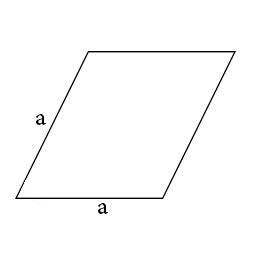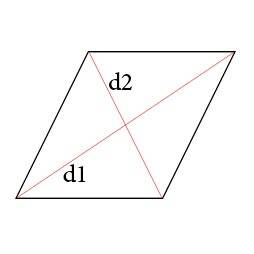В данной публикации мы рассмотрим, каким образом можно посчитать периметр ромба и разберем примеры решения задач.
- Формула вычисления периметра
- Примеры задач
Формула вычисления периметра
1. По длине стороны
Периметр (P) ромба равняется сумме длин всех его сторон.
P = a + a + a + a
Т.к. все стороны данной геометрической фигуры равны, формулу можно представить в следующем виде (сторона умноженная на 4):
P = 4*a
2. По длине диагоналей
Диагонали любого ромба пересекаются под углом 90° и в точке пересечения делятся пополам, т.е.:
- AO=OC=d1/2
- BO=OD=d2/2
Диагонали делят ромб на 4 равных прямоугольных треугольника: AOB, AOD, BOC и DOC. Давайте подробнее остановимся на AOB.
Найти сторону AB, которая одновременно является гипотенузой прямоугольника и стороной ромба, можно, воспользовавшись теоремой Пифагора:
AB2 = AO2 + OB2
Подставляем в эту формулу длины катетов, выраженные через половины диагоналей, и получаем:
AB2 = (d1/2)2 + (d2/2)2, или
Таким образом, периметр равняется:
Примеры задач
Задание 1
Найдите периметр ромба, если длина его стороны составляет 7 см.
Решение:
Используем первую формулу, подставив в нее известное значение: P = 4 * 7 см = 27 см.
Задание 2
Периметр ромба равен 44 см. Найдите сторону фигуры.
Решение:
Как мы знаем, P = 4*a. Следовательно, чтобы найти одну сторону (a), необходимо периметр разделить на четыре: a = P/4 = 44 см / 4 = 11 см.
Задание 3
Найдите периметр ромба, если известны его диагонали: 6 и 8 см.
Решение:
Воспользовавшись формулой, в которой задействованы длины диагоналей, получаем:
Чтобы найти периметр ромба достаточно знать его сторону или диагонали и воспользоваться простейшей формулой. Чтобы облегчить эту задачу мы создали онлайн калькулятор, который мгновенно найдет периметр.
У нас вы также можете рассчитать периметр других четырехугольников: квадрата, прямоугольника, параллелограмма, трапеции.
Содержание:
- калькулятор периметра ромба
- формула периметра ромба через сторону
- формула периметра ромба через диагонали
- примеры задач
Ромб – параллелограмм, у которого все стороны равны.
Формула периметра ромба через сторону
{P = 4a}
a – сторона ромба
Формула периметра ромба через диагонали
{P = 2 sqrt{{d_1}^2+{d_2}^2}}
d1 и d2 – диагонали ромба
Примеры задач на нахождение периметра ромба
Задача 1
Найдите периметр ромба, если его диагонали равны 60см и 80см.
Решение
Для решения задачи используем вторую формулу.
P = 2 sqrt{{d_1}^2+{d_2}^2} = 2 sqrt{{60}^2+{80}^2} = 2 sqrt{3600+6400} = 2 sqrt{10000} = 2 cdot 100 = 200 : см
Ответ: 200 см
Проверим ответ на калькуляторе .
Задача 2
Найти периметр ромба, если его сторона равна 12см.
Решение
Воспользуемся первой формулой. Подставим в нее значение стороны ромба и вычислим его периметр:
P = 4a = 4 cdot 12 = 48 : см
Ответ: 48 см
Проверим ответ с использованием калькулятора .
При помощи нашего калькулятора вы легко сможете узнать периметр ромба.
Для того, что бы вычислить периметр ромба нам необходимо знать длину его стороны. Как только нам стала известна длина одной из его сторон и зная что ромб состоит из четырех одинаковых по своей дине стороны мы можем легко вычислить его периметр по нижеследующей формуле:
P=a+a+a+a
P = a4
Так же периметр ромба можно вычислить зная длину его диагоналей, т.к. при пересечении диагонали образуют угол равный 90° и тем самым делят ромб на четыре прямоугольных треугольника. Далее используя теорему Пифагора в которой говориться , что квадрат гипотенузы равен сумме квадратов катетов, мы с легкостью сможем высчитать периметр ромба по следующей формуле
Download Article
Download Article
A rhombus is a parallelogram with four congruent sides.[1]
These properties allow for numerous methods for finding the perimeter. Since all four sides of a rhombus are of equal length, finding the perimeter is possible when one side length is known. However, using geometry and trigonometry, it is also possible to find the perimeter even if you do not know the lengths of any sides of the rhombus.
-
1
Set up the formula for perimeter of a rhombus. Since, by definition, all four sides of a rhombus are the same length, the formula is
, where
equals the perimeter, and
equals the length of one side.[2]
- You could also use the formula
to find the perimeter, since the perimeter of any polygon is the sum of all its sides.[3]
- If you know that not all sides are the same length, then you are not working with a rhombus, and you cannot use this formula.
- If you don’t know the length of any side of the rhombus, you cannot use this method.
- A square is a special type of rhombus, with four 90-degree angles.
- You could also use the formula
-
2
Plug in the side length of the rhombus. Make sure you are substituting for the variable
.
- For example, if you know one side of the rhombus is 4 meters long, your formula will look like this:
.
Advertisement
- For example, if you know one side of the rhombus is 4 meters long, your formula will look like this:
-
3
Solve for
. To do this, multiply
by 4.
Advertisement
-
1
Notice that the two diagonals of your rhombus create four congruent triangles. Outline one of these triangles. You will use it to find the length of one side of the rhombus.
- Since the triangles are congruent, it doesn’t matter which one you outline.
-
2
Identify the 90 degree angle of your triangle. The two diagonals of a rhombus are perpendicular, so the central angle of your triangle will be 90 degrees. [4]
-
3
Label the hypotenuse of your triangle. The hypotenuse is the side opposite a 90 degree angle.[5]
Traditionally, the hypotenuse is labeled.
- The hypotenuse of your triangle is one side of the rhombus. So, if you find the length of
, you will know the length of one side of the rhombus.
- The hypotenuse of your triangle is one side of the rhombus. So, if you find the length of
-
4
Label the other two sides of your triangle. Traditionally, these are labeled
and
.
-
5
Find the length of side
. To do this, divide the length of the diagonal that
runs along by 2. Label the side length on your triangle.
-
6
Find the length of side
. To do this, divide the length of the diagonal that
runs along by 2. Label the side length on your triangle.
-
7
Set up the Pythagorean Theorem. The theorem states that
. This is a basic geometric formula for finding the side lengths of a right triangle.
-
8
Plug in the known side lengths of your triangle into the Pythagorean Theorem. Make sure you substitute for
and
, but the order doesn’t matter due to the commutative property.
-
9
-
10
-
11
Write your final answer. Don’t forget to include the correct unit of measurement.
- For example, a rhombus that has diagonals measuring 12 and 16 meters long has a perimeter of 40 meters.
Advertisement
-
1
Label the vertices of your rhombus, if they are not already labeled. It doesn’t matter which variables you give them.
-
2
Notice that the two diagonals of your rhombus create four congruent triangles. Outline one of these triangles. You will use it to find the length of one side of the rhombus.
- Since the triangles are congruent, it doesn’t matter which one you outline; however, for simplicity you should outline a triangle that shares a known angle of the rhombus.
- For example, I know that angle
of the rhombus is 70 degrees, so I would outline a triangle that includes point A.
-
3
Identify the 90 degree angle of your triangle. The two diagonals of a rhombus are perpendicular, so the central angle of your triangle will be 90 degrees. [7]
If this angle is not already labeled, label it.
-
4
-
5
Determine the measurement of the missing angle. Remember, the interior degrees of a triangle will add up to 180.[9]
So, if you know the measurement of two angles, you can subtract to find the measurement of the third angle. Label the degrees for this angle on your triangle. -
6
Determine the length of one side of your triangle. To do this, divide the length of the diagonal that the side runs along by 2. Label the side length on your triangle.
-
7
Set up a sine or cosine ratio. Whether you use sine or cosine will depend on which side and angle measurements of your triangle you know. For more information, read Use Right Angled Trigonometry.
- If you know the length of the side opposite to your angle, use sine. Set up the ratio
, where
is the measurement of the angle, “Opposite” is the length of the opposite side, and
is the length of the hypotenuse.
- If you know the length of the side adjacent to your angle, use cosine. Set up the ratio
. Where
is the measurement of the angle, “Adjacent” is the length of the adjacent side, and
is the length of the hypotenuse.
- For example, if you know that angle
of your triangle is 35 degrees, and the adjacent side is 8 centimeters, you should use cosine:
- If you know the length of the side opposite to your angle, use sine. Set up the ratio
-
8
Solve the ratio to find the length of the hypotenuse. The length of the hypotenuse is also the length of one side of your rhombus, so you need this measurement to find the perimeter of the rhombus.
-
9
-
10
Write your final answer. Your answer will be approximate since you rounded the sine or cosine measurement. Don’t forget to include the correct unit of measurement.
Advertisement
Add New Question
-
Question
What is the perimeter and area of a rhombus with diagonals of 24 cm and 7 cm?
To find the perimeter, follow the steps described in method 2, where you use the lengths of the diagonals to set up the Pythagorean Theorem.
1/2 of 24 = 12; 1/2 of 7 = 3.5.
So:
12^2 + 3.5^2 = c^2
144 + 12.25 = c^2
156.25 = c^2
12.5 = c, or the length of one side of the rhombus (S)
P = 4S
P = 4(12.5)
P= 50 cmTo find the area, you can read the article “Calculate the Area of a Rhombus.” (http://www.wikihow.com/Calculate-the-Area-of-a-Rhombus)
-
Question
What if the sides are not equal?
If the sides of the shape are not equal, then the figure is not a rhombus. You can still find the perimeter of any shape by adding up the length of all its sides.
-
Question
How do I find the perimeter of a rhombus whose area is 60 cm2 and has a diagonal of 15 cm?
The area (60) is half the product of the diagonals. If d is the unknown diagonal, then 60 = 15d / 2. So 15d = 120, and d = 8 cm. The diagonals of a rhombus are perpendicular to and bisect each other, forming four right triangles, each with legs of 7.5 cm and 4 cm (half each diagonal). By the Pythagorean theorem, we find that each of the sides of the rhombus is √([7.5)² + (4)²] = √[56.25 + 16] = √72.25 = 8.5 cm. The perimeter of the rhombus is four times the length of one side: 34 cm.
See more answers
Ask a Question
200 characters left
Include your email address to get a message when this question is answered.
Submit
Advertisement
Video
-
You can add up the lengths of the sides to get the perimeter of any polygon – a triangle, rectangle, pentagon, or other straight-sided shape. Circles and other curved shapes require different formulas.
Thanks for submitting a tip for review!
Advertisement
References
About This Article
Article SummaryX
To find the perimeter of a rhombus when you have the length of one of the sides, multiply that length by 4. This works because all 4 sides of a rhombus are equal length. Keep reading to learn how to use the Pythagorean Theorem to find the perimeter of a rhombus when you know the diagonal!
Did this summary help you?
Thanks to all authors for creating a page that has been read 102,439 times.
Did this article help you?
Периметр ромба калькулятор онлайн умеет вычислять периметр двумя способами:
- По стороне ромба.
- По диагоналям ромба.
Сделав расчет периметра на этом онлайн калькуляторе Вы получите не только ответ, но и детальное, пошаговое решение с выводом формул и промежуточных действий.
Периметр ромба- это сумма всех его сторон.
Так как у ромба все стороны равны, то периметр равен длине любой его стороны, умноженной на четыре.
Как найти периметр ромба?
Найти периметр ромба очень просто на нашем онлайн калькуляторе. Так же периметр может быть найден самостоятельно по формулам. Выбор нужной формулы зависит от того какие данные известны.
1) По стороне ромба
где a- любая из равных сторон ромба.
2) По двум диагонялям
где d1,d2 – диагонали ромба.


















































